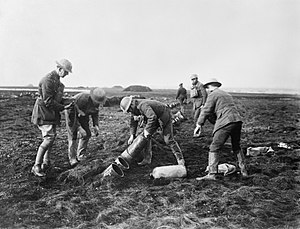Livens Projector
| Livens Projector | |
|---|---|

|
|
| Type | Mortar |
| Place of origin | United Kingdom |
| Service history | |
| In service | 1916–1918 |
| Used by |
British Empire United States |
| Wars | World War I |
| Production history | |
| Designer | Captain William Howard Livens, Royal Engineers |
| Designed | 1916 |
| No. built | 140,000 projectors 400,000 bombs |
| Specifications | |
| Shell | Gas drum |
| Calibre | 8 inches (200 mm) |
| Elevation | fixed |
| Traverse | fixed |
| Maximum firing range | 1,640 yd (1,500 m) |
| Filling | phosgene,flammable oil |
| Filling weight | 30 lb (14 kg) |
|
Detonation
mechanism |
Impact |
The Livens Projector was a simple mortar-like weapon that could throw large drums filled with flammable or toxic chemicals.
In the First World War, the Livens Projector became the British Army's standard means of delivering gas attacks and it remained in its arsenal until the early years of the Second World War.
The Livens Projector was created by the British army officer Captain William H. Livens of the Royal Engineers. Livens designed a number of novel weapons including a large calibre flame thrower, designed to engulf German trenches in burning oil, that was deployed at the Somme in 1916. (One of these weapons was partially excavated in 2010 for an episode of archaeological television programme Time Team, having been buried as the tunnel in which it was being built took a direct hit from a German shell.) Later, in World War II, he worked on petroleum warfare weapons such as the flame fougasse and various other flame throwing weapons.
Prior to the invention of the Livens Projector, chemical weapons had been delivered either by "cloud attacks" or chemical-filled shells fired from howitzers. Cloud attacks at first were made by burying gas-filled cylinder tanks just beyond the parapet of the attacker's trenches and then opening valves on the tanks when the wind was right. (Later British practice was to bring up flatcars with gas cylinders on a line parallel to the front to be attacked, and open the cylinders without removing them from the rail car.) This allowed a useful amount of gas to be released but there was danger that the wind would change and the gas would drift back over the attacking troops. Chemical shells were much easier to direct at the enemy but could not deliver nearly as much gas as a cylinder tank.
Livens was in command of Z company, the unit charged with developing and using flame and chemical weapons. Flame throwers and various means of dispensing chemicals had proven frustratingly limited in effect. One day, during an attack on the Somme, Z company encountered a party of Germans who were well dug in. Grenades did not succeed in shifting them, so Livens improvised a sort of giant Molotov cocktail using two 5 gallon oil drums. When these were thrown into the German positions they were so effective that Livens's comrade Harry Strange wondered whether it would be better to use containers to carry the flame to the enemy rather than relying on a complex flame thrower.
...
Wikipedia
